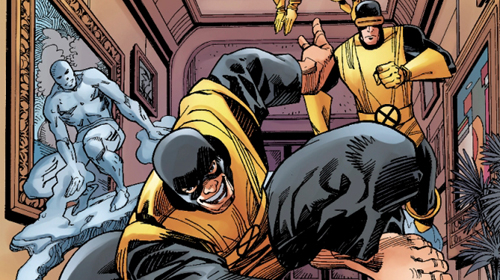X-Men Gold #1
Written by Chris Claremont, Louise Simonson, Stan Lee, Roy Thomas, Len Wein & Fabian Nicieza.
Art by Bob McLeod, Walt Simonson, Pat Olliffe, Jorge Molina & Salvador Larroca. Colorists Israel Silva, Andres Mossa, Chris Sotomayor, Jorge Molina, & David Ocampa.
Cover by Oliver Coipel.
Published by Marvel Comics
X-Men Gold, a special one-shot designed to celebrate the 50th anniversary of the X-Men, features an assortment of stories set in notable eras from the team’s history, by creators who, in some cases, made significant contributions to that history. As is the case with most anthology issues, the end result is something of a mixed bag, even while it accomplishes the goal of surveying X-Men history.
The centerpiece of the issue is a story written by Chris Claremont with art by Bob McLeod. Set during the Claremont/Paul Smith run on Uncanny X-Men (specifically, between pages of Uncanny X-Men #174), it is a fairly straightforward story involving the X-Men and their space faring allies, the Starjammers, fighting Sentinels in China. The Sentinels are an effective choice for a story like this, as they require little in the way of introduction or motivation (big robots, hunts mutants) and serve as a physical representation of the prejudice against which the X-Men are always fighting. Claremont slides easily enough into the voices of his old charges, while McLeod (who, in addition to co-creating the spinoff New Mutants with Claremont, penciled a handful of X-Men issues back in the day) gives the whole story a clean, smooth look, reminiscent at times of Paul Smith’s own animation-inspired work on X-Men (though McLeod’s art here lacks the strong sense of body language and attention-to-detail that Smith brought to his work).
The rest of the issue is comprised of a series of five page stories, the standout of which is the first, a tale of the original X-Men. Though light on plot (credited to longtime X-Men editor and X-Factor and New Mutants writer Louise Simonson, it’s essentially “the male X-Men race to the Danger Room to win a date with Jean Grey”), the pages crackle with energy thanks to art by Walt Simonson and Bob Wiacek (who, amongst other things, worked on a good chunk of Louise Simonson’s X-Factor stories), while X-Men co-creator Stan Lee, who scripts the story, punches things up with his trademark bombastic dialogue and huckster narration.
After that are a pair of less successful stories. The first, by Roy Thomas and Pat Olliffe, features Banshee and Sunfire bonding over a shared love of Elvis set two days before Giant-Size X-Men #1, the seminal issue which introduced the “new X-Men” (featuring such fan favorites as Nightcrawler, Storm and Wolverine). Thomas’ dialogue and narration, lacking the familiar rhythms and purple prose of Claremont and the bombast of Stan Lee, is unexciting, while Olliffe’s art is serviceable but bland. After that is a tale by Len Wein (writer of Giant-Size X-Men #1 and co-creator of Wolverine) and Jorge Molina, set amidst the pages of Giant-Size, featuring Wolverine musing on the best way to kill his new teammates, should such a thing become necessary. It’s an interesting idea in theory, but comes up short in execution, a victim of the small page count.
The final story comes from Fabian Nicieza, one of the two writers responsible for shepherding the X-Men for much of the 90s, with art by Salvador Larroca (who had a lengthy run on X-Treme X-Men with Claremont in the 90s). It is set during Nicieza’s X-Men (vol. 2) #25, specifically the moment in which Professor X wipes Magneto’s mind in retaliation for Magneto forcefully pulling the metal from Wolverine’s bones, in a “what if?” scenario where Magneto and Xavier remain friends and have successfully forged peace between humans and mutants. The story is a clever use of the “historical survey” mandate of the anthology, and is impressive for the way Nicieza & Larrocca manage to craft a realized world and speak to the themes of the X-Men while packing in some surprises and Easter eggs in just a few pages.
Overall, X-Men Gold certainly isn’t required reading, either in terms of significance to the ongoing X-Men saga or in terms of overall creative execution, but for any new fans looking for a primer on X-Men history or longtime fans wanting to take a trip down memory lane, it’s an effective and enjoyable issue.

